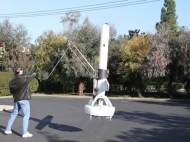UAV with depth perception able to manipulate objects
 While most of us can easily manipulate with everyday objects around us and place them at a desired place by using a series of judgments requiring vision, stability and careful movement, creating a robot able to perform a similar task is a bit of a challenge. A DARPA-funded research led to a hovering unmanned aerial vehicle (UAV) able to manipulate objects with vision-driven robotic-arm payload emplacement.
While most of us can easily manipulate with everyday objects around us and place them at a desired place by using a series of judgments requiring vision, stability and careful movement, creating a robot able to perform a similar task is a bit of a challenge. A DARPA-funded research led to a hovering unmanned aerial vehicle (UAV) able to manipulate objects with vision-driven robotic-arm payload emplacement.
They used MLB Company’s tail-sitter UAV named V-Bat, and it is capable of both hover and wing-borne flight, thus enabling greater maneuvering during the payload delivery and precision emplacement. It uses a low-cost vision system developed by DARPA to estimate the target’s position relative to the hovering vehicle in real time. This vision system enables the UAV to search and find the target for the emplacement autonomously and then perform the action.
The MLB V-Bat is a long endurance vertical take-off and landing (VTOL) UAV. The aircraft can be launched and recovered from a small area, and its default version can fly for up to 10 hours with a 2.27 kg (5 lbs) payload. Versions as large as 3 m (10 ft) in span and 31 kg (70 lbs) and as small as 1.82 m (6 ft) in span and 5.44 kg (12 lbs) have been tested to date, but its first production version weights 25 kg (55 lbs) and has a 2.4 (8 ft) span.
It employs control logic which maneuvers the vehicle and directs the robotic arm to accurately engage the emplacement target employs a newly developed stereo vision system that tracks the emplacement target and motion of the robotic arm. The vision system, coupled with global positioning system, controls the arm and V-Bat during emplacement. The arm can be extended up to 1.83 meters (6 feet) and carry a 0.45 kg (1-pound) payload.
“Our goal with the UAV payload emplacement demonstration was to show we could quickly develop and integrate the right technology to make this work”, said Dan Patt, DARPA program manager. “The success of the demonstration further enables the capabilities of future autonomous aerial vehicles.”
Although it is still in its early development and it can’t carry heavy loads, the precision emplacement technology developed by DARPA could be used in other configurations and pave the way for precise long-range delivery of small payloads into hazardous or difficult-to-reach environments.









Leave your response!